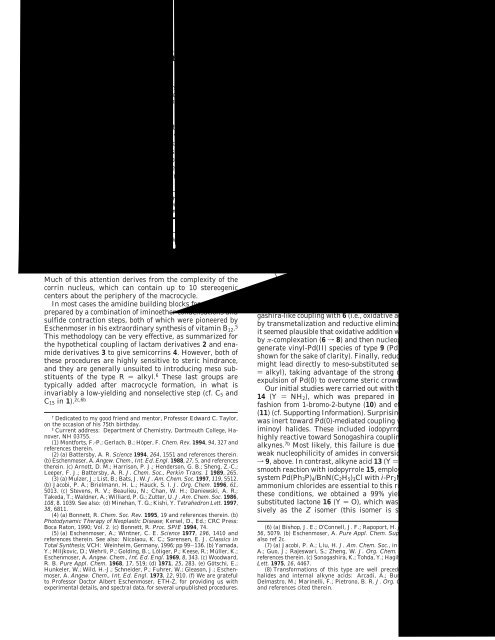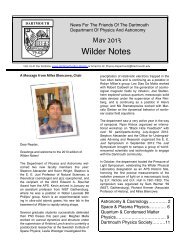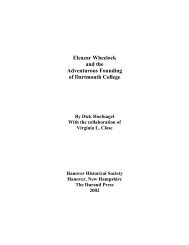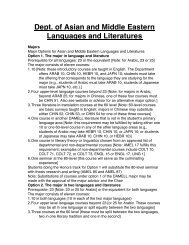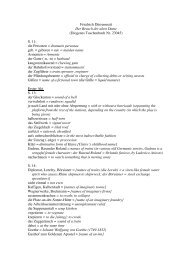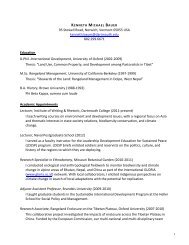Studies on Corrin Synthesis. A Solution to the Introduction of Meso ...
Studies on Corrin Synthesis. A Solution to the Introduction of Meso ...
Studies on Corrin Synthesis. A Solution to the Introduction of Meso ...
You also want an ePaper? Increase the reach of your titles
YUMPU automatically turns print PDFs into web optimized ePapers that Google loves.
<str<strong>on</strong>g>Studies</str<strong>on</strong>g> <strong>on</strong> <strong>Corrin</strong> <strong>Syn<strong>the</strong>sis</strong>. A Soluti<strong>on</strong> <strong>to</strong><br />
<strong>the</strong> Introducti<strong>on</strong> <strong>of</strong> <strong>Meso</strong> Substituents †<br />
Peter A. Jacobi* ,‡ and Hui Liu<br />
Department <strong>of</strong> Chemistry, Wesleyan University, Middle<strong>to</strong>wn,<br />
C<strong>on</strong>necticut 06459-0180, and Burke Chemical Labora<strong>to</strong>ry,<br />
Dartmouth College, Hanover, New Hampshire 03755<br />
Received December 29, 1998<br />
Cobyric acid (1) is a member <strong>of</strong> <strong>the</strong> corrin class <strong>of</strong><br />
hydroporphyrins, 1 which incorporate a vinylogous amidine<br />
chromophore within a tetrapyrroline skelet<strong>on</strong>. Members <strong>of</strong><br />
this class have been <strong>the</strong> subject <strong>of</strong> extensive studies, not <strong>on</strong>ly<br />
because <strong>of</strong> <strong>the</strong>ir biological importance but also due <strong>to</strong> <strong>the</strong>ir<br />
intriguing biosyn<strong>the</strong>tic pathway. 2 Recently, this area has<br />
seen a resurgence <strong>of</strong> interest from syn<strong>the</strong>tic chemists. 3,4<br />
Recently, we described an iterative syn<strong>the</strong>sis <strong>of</strong> semicorrins<br />
4a (R ) H), building up<strong>on</strong> <strong>the</strong> facile transformati<strong>on</strong> <strong>of</strong><br />
pentynoic acids 5 <strong>to</strong> pyrroline derivatives 6 (X ) Cl, OTf). 7a<br />
Pyrrolines 6 were <strong>the</strong>n c<strong>on</strong>verted <strong>to</strong> 4a by a two-step<br />
sequence involving Pd(0)-mediated coupling <strong>of</strong> 6 with terminal<br />
alkyne amides 7a (R ) H), followed by 5-exo-dig<br />
cyclizati<strong>on</strong> <strong>of</strong> <strong>the</strong> resultant pyrrolinoalkynes (not shown). 7b<br />
Much <strong>of</strong> this attenti<strong>on</strong> derives from <strong>the</strong> complexity <strong>of</strong> <strong>the</strong><br />
corrin nucleus, which can c<strong>on</strong>tain up <strong>to</strong> 10 stereogenic<br />
centers about <strong>the</strong> periphery <strong>of</strong> <strong>the</strong> macrocycle.<br />
In most cases <strong>the</strong> amidine building blocks for corrins are<br />
prepared by a combinati<strong>on</strong> <strong>of</strong> iminoe<strong>the</strong>r c<strong>on</strong>densati<strong>on</strong>s and<br />
sulfide c<strong>on</strong>tracti<strong>on</strong> steps, both <strong>of</strong> which were pi<strong>on</strong>eered by<br />
Eschenmoser in his extraordinary syn<strong>the</strong>sis <strong>of</strong> vitamin B 12 . 5<br />
This methodology can be very effective, as summarized for<br />
<strong>the</strong> hypo<strong>the</strong>tical coupling <strong>of</strong> lactam derivatives 2 and enamide<br />
derivatives 3 <strong>to</strong> give semicorrins 4. However, both <strong>of</strong><br />
<strong>the</strong>se procedures are highly sensitive <strong>to</strong> steric hindrance,<br />
and <strong>the</strong>y are generally unsuited <strong>to</strong> introducing meso substituents<br />
<strong>of</strong> <strong>the</strong> type R ) alkyl. 6 These last groups are<br />
typically added after macrocycle formati<strong>on</strong>, in what is<br />
invariably a low-yielding and n<strong>on</strong>selective step (cf. C 5 and<br />
C 15 in 1). 2c,6b<br />
†<br />
Dedicated <strong>to</strong> my good friend and men<strong>to</strong>r, Pr<strong>of</strong>essor Edward C. Taylor,<br />
<strong>on</strong> <strong>the</strong> occasi<strong>on</strong> <strong>of</strong> his 75th birthday.<br />
‡<br />
Current address: Department <strong>of</strong> Chemistry, Dartmouth College, Hanover,<br />
NH 03755.<br />
(1) M<strong>on</strong>tforts, F.-P.; Gerlach, B.; Höper, F. Chem. Rev. 1994, 94, 327 and<br />
references <strong>the</strong>rein.<br />
(2) (a) Battersby, A. R. Science 1994, 264, 1551 and references <strong>the</strong>rein.<br />
(b) Eschenmoser, A. Angew. Chem., Int. Ed. Engl. 1988, 27, 5, and references<br />
<strong>the</strong>rein. (c) Arnott, D. M.; Harris<strong>on</strong>, P. J.; Henders<strong>on</strong>, G. B.; Sheng, Z.-C.;<br />
Leeper, F. J.; Battersby, A. R. J. Chem. Soc., Perkin Trans. 1 1989, 265.<br />
(3) (a) Mulzer, J.; List, B.; Bats, J. W. J. Am. Chem. Soc. 1997, 119, 5512.<br />
(b) Jacobi, P. A.; Brielmann, H. L.; Hauck, S. I. J. Org. Chem. 1996, 61,<br />
5013. (c) Stevens, R. V.; Beaulieu, N.; Chan, W. H.; Daniewski, A. R.;<br />
Takeda, T.; Waldner, A.; Williard, P. G.; Zutter, U. J. Am. Chem. Soc. 1986,<br />
108, 8. 1039. See also: (d) Minehan, T. G.; Kishi, Y. Tetrahedr<strong>on</strong> Lett. 1997,<br />
38, 6811.<br />
(4) (a) B<strong>on</strong>nett, R. Chem. Soc. Rev. 1995, 19 and references <strong>the</strong>rein. (b)<br />
Pho<strong>to</strong>dynamic Therapy <strong>of</strong> Neoplastic Disease; Kersel, D., Ed.; CRC Press:<br />
Boca Rat<strong>on</strong>, 1990; Vol. 2. (c) B<strong>on</strong>nett, R. Proc. SPIE 1994, 74.<br />
(5) (a) Eschenmoser, A.; Wintner, C. E. Science 1977, 196, 1410 and<br />
references <strong>the</strong>rein. See also: Nicolaou, K. C.; Sorensen, E. J. Classics in<br />
Total <strong>Syn<strong>the</strong>sis</strong>; VCH: Weinheim, Germany, 1996; pp 99-136. (b) Yamada,<br />
Y.; Miljkovic, D.; Wehrli, P.; Golding, B.;, Löliger, P.; Keese, R.; Müller, K.;<br />
Eschenmoser, A. Angew. Chem., Int. Ed. Engl. 1969, 8, 343. (c) Woodward,<br />
R. B. Pure Appl. Chem. 1968, 17, 519; (d) 1971, 25, 283. (e) Götschi, E.;<br />
Hunkeler, W.; Wild, H.-J.; Schneider, P.; Fuhrer, W.; Gleas<strong>on</strong>, J.; Eschenmoser,<br />
A. Angew. Chem., Int. Ed. Engl. 1973, 12, 910. (f) We are grateful<br />
<strong>to</strong> Pr<strong>of</strong>essor Doc<strong>to</strong>r Albert Eschenmoser, ETH-Z, for providing us with<br />
experimental details, and spectral data, for several unpublished procedures.<br />
In this paper, we describe our studies with internal alkyne<br />
amides 7b (R ) alkyl), which cannot undergo direct S<strong>on</strong>ogashira-like<br />
coupling with 6 (i.e., oxidative additi<strong>on</strong>, followed<br />
by transmetalizati<strong>on</strong> and reductive eliminati<strong>on</strong>). 7c Instead,<br />
it seemed plausible that oxidative additi<strong>on</strong> would be followed<br />
by π-complexati<strong>on</strong> (6 f 8) and <strong>the</strong>n nucleophilic capture <strong>to</strong><br />
generate vinyl-Pd(II) species <strong>of</strong> type 9 (Pd ligands are not<br />
shown for <strong>the</strong> sake <strong>of</strong> clarity). Finally, reductive eliminati<strong>on</strong><br />
might lead directly <strong>to</strong> meso-substituted semicorrins 4b (R<br />
) alkyl), taking advantage <strong>of</strong> <strong>the</strong> str<strong>on</strong>g driving force for<br />
expulsi<strong>on</strong> <strong>of</strong> Pd(0) <strong>to</strong> overcome steric crowding. 8<br />
Our initial studies were carried out with <strong>the</strong> alkyne amide<br />
14 (Y ) NH 2 ), which was prepared in straightforward<br />
fashi<strong>on</strong> from 1-bromo-2-butyne (10) and ethyl isobutyrate<br />
(11) (cf. Supporting Informati<strong>on</strong>). Surprisingly, however, 14<br />
was inert <strong>to</strong>ward Pd(0)-mediated coupling with a variety <strong>of</strong><br />
iminoyl halides. These included iodopyrrole 15, which is<br />
highly reactive <strong>to</strong>ward S<strong>on</strong>ogashira coupling with terminal<br />
alkynes. 7b Most likely, this failure is due <strong>to</strong> <strong>the</strong> relatively<br />
weak nucleophilicity <strong>of</strong> amides in c<strong>on</strong>versi<strong>on</strong>s <strong>of</strong> <strong>the</strong> type 8<br />
f 9, above. In c<strong>on</strong>trast, alkyne acid 13 (Y ) OH) underwent<br />
smooth reacti<strong>on</strong> with iodopyrrole 15, employing <strong>the</strong> reagent<br />
system Pd(Ph 3 P) 4 /BnN(C 2 H 5 ) 3 Cl with i-Pr 2 NEt (quaternary<br />
amm<strong>on</strong>ium chlorides are essential <strong>to</strong> this reacti<strong>on</strong>). 8 Under<br />
<strong>the</strong>se c<strong>on</strong>diti<strong>on</strong>s, we obtained a 99% yield <strong>of</strong> <strong>the</strong> mesosubstituted<br />
lact<strong>on</strong>e 16 (Y ) O), which was obtained exclusively<br />
as <strong>the</strong> Z isomer (this isomer is stabilized by an<br />
(6) (a) Bishop, J. E.; O’C<strong>on</strong>nell, J. F.; Rapoport, H. J. Org. Chem. 1991,<br />
56, 5079. (b) Eschenmoser, A. Pure Appl. Chem. Suppl. 1971, 2, 69. See<br />
also ref 2c.<br />
(7) (a) Jacobi, P. A.; Liu, H. J. Am. Chem. Soc., in press. (b) Jacobi, P.<br />
A.; Guo, J.; Rajeswari, S.; Zheng, W. J. Org. Chem. 1997, 62, 2907 and<br />
references <strong>the</strong>rein. (c) S<strong>on</strong>ogashira, K.; Tohda, Y.; Hagihara, N. Tetrahedr<strong>on</strong><br />
Lett. 1975, 16, 4467.<br />
(8) Transformati<strong>on</strong>s <strong>of</strong> this type are well precedented for vinyl/aryl<br />
halides and internal alkyne acids: Arcadi, A.; Burini, A.; Cacchi, S.;<br />
Delmastro, M.; Marinelli, F.; Pietr<strong>on</strong>o, B. R. J. Org. Chem. 1992, 57, 976<br />
and references cited <strong>the</strong>rein.
internal hydrogen b<strong>on</strong>d). Finally, brief exposure <strong>of</strong> 16 <strong>to</strong><br />
liquid NH 3 , followed by dehydrati<strong>on</strong> (P 2 O 5 ), gave an 89%<br />
overall yield <strong>of</strong> <strong>the</strong> desired enamide 17 (Y ) NH; E:Z )<br />
4:5). 7a,9<br />
The Pd methodology was readily extended <strong>to</strong> <strong>the</strong> syn<strong>the</strong>sis<br />
<strong>of</strong> meso-substituted semicorrins. For example, Pd(0)-mediated<br />
coupling <strong>of</strong> 13 with <strong>the</strong> iminoyl chloride 18a (A ) Me,<br />
B ) H) afforded a 91% yield <strong>of</strong> <strong>the</strong> enol-lact<strong>on</strong>e 19a, which<br />
was obtained as a 1:1 mixture <strong>of</strong> E and Z isomers (GC-<br />
MS). In this case, intramolecular hydrogen b<strong>on</strong>ding is not<br />
possible, and <strong>the</strong> E:Z ratio reflects steric interacti<strong>on</strong>s. Ring<br />
opening <strong>of</strong> 19a with NH 3 /dioxane <strong>the</strong>n gave a 97% yield <strong>of</strong><br />
<strong>the</strong> ket<strong>on</strong>e amide 20a, which up<strong>on</strong> dehydrati<strong>on</strong> was cleanly<br />
c<strong>on</strong>verted <strong>to</strong> <strong>the</strong> desired semicorrin 21a (P 2 O 5 , 77%). Not<br />
S<strong>on</strong>ogashira coupling <strong>of</strong> 26 with <strong>the</strong> alkyne amide 27 <strong>the</strong>n<br />
led directly <strong>to</strong> <strong>the</strong> iminolact<strong>on</strong>e derivative 28 (69%), via a<br />
reacti<strong>on</strong> pathway that most likely involves chelati<strong>on</strong> <strong>of</strong> Cu. 7a<br />
In any event, acid-catalyzed Dimroth rearrangement <strong>of</strong> 28<br />
gave an 83% yield <strong>of</strong> <strong>the</strong> Z,Z-tripyrroline 29, 7a which is<br />
closely related <strong>to</strong> rings A-C in1.<br />
Fur<strong>the</strong>r iterati<strong>on</strong>s <strong>of</strong> this process are possible, <strong>to</strong> produce<br />
tetrapyrroles and higher analogues. 7a However, it is sometimes<br />
preferable <strong>to</strong> employ a more c<strong>on</strong>vergent approach.<br />
Following literature precedent, 5e,f enamide 25 was c<strong>on</strong>verted<br />
<strong>to</strong> semicorrin derivatives 31b (R = Me) and 33b (R = Me)<br />
and <strong>the</strong>n <strong>to</strong> vinyl sulfide 34b by coupling with DBU. Finally,<br />
surprisingly, 21a was obtained exclusively as <strong>the</strong> Z isomer,<br />
due <strong>to</strong> internal hydrogen b<strong>on</strong>ding. In identical fashi<strong>on</strong>,<br />
iminoyl chloride 18b (A ) H, B ) Me) underwent coupling<br />
with 13 <strong>to</strong> afford a 77% yield <strong>of</strong> <strong>the</strong> enol lact<strong>on</strong>e 19b, which<br />
because <strong>of</strong> str<strong>on</strong>g steric crowding exists predominantly in<br />
<strong>the</strong> E c<strong>on</strong>figurati<strong>on</strong> (E:Z ) 10:1). Once again, however,<br />
aminolysis followed by dehydrati<strong>on</strong> provided <strong>on</strong>ly <strong>the</strong> (Z)-<br />
semicorrin 21b, in>80% overall yield.<br />
It was important <strong>to</strong> test <strong>the</strong> compatibility <strong>of</strong> this methodology<br />
with steric hindrance in ring B, which is a critical<br />
issue in <strong>the</strong> syn<strong>the</strong>sis <strong>of</strong> semicorrins related <strong>to</strong> cobyric acid<br />
(1). 6b This questi<strong>on</strong> was explored using <strong>the</strong> alkyne acid 22b<br />
(R ) Me), which was readily prepared by methylati<strong>on</strong> <strong>of</strong> 22a<br />
(R ) H) using LDA/MeI (69%). We were pleased <strong>to</strong> find that<br />
Pd(0)-mediated coupling <strong>of</strong> 18a with 22b gave a 69% yield<br />
<strong>of</strong> <strong>the</strong> corresp<strong>on</strong>ding enol lact<strong>on</strong>e 23 (analogous <strong>to</strong> 19a,<br />
above), which up<strong>on</strong> aminolysis, and subsequent dehydrati<strong>on</strong>,<br />
afforded semicorrin 25 in 92% yield (lactam tau<strong>to</strong>mer, Z<br />
isomer <strong>on</strong>ly). In comparis<strong>on</strong>, all attempts at preparing 25<br />
employing <strong>the</strong> sulfide c<strong>on</strong>tracti<strong>on</strong> procedure failed (i.e.,<br />
coupling <strong>of</strong> thiolactam 2a [A ) Me 2 ,B) H, Y ) SH] with<br />
enamide 3a [C ) Me 2 ,D) H, R ) Me, Z ) I], see above).<br />
Finally, <strong>the</strong> iterative capability <strong>of</strong> this strategy was dem<strong>on</strong>strated<br />
by c<strong>on</strong>verting 25 <strong>to</strong> <strong>the</strong> iminoyl chloride 26 (X )<br />
Cl), which was cleanly accomplished using CCl 4 /Ph 3 P (72%).<br />
(9) See, for example: Micklefield, J.; Mackman, R. L.; Aucken, C. J.;<br />
Beckmann, M.; Block, M. H.; Leeper, F. J.; Battersby, A. R. J. Chem. Soc.<br />
Chem. Commun 1993, 275 and references <strong>the</strong>rein.<br />
sulfide c<strong>on</strong>tracti<strong>on</strong> <strong>of</strong> 34b <strong>to</strong> secocorphin 35b was accomplished<br />
in 69% yield (81% based <strong>on</strong> recovered 34b),<br />
following <strong>the</strong> procedure <strong>of</strong> Eschenmoser. 5e,f In this case<br />
tetrapyrrole formati<strong>on</strong> is facilitated by metal chelati<strong>on</strong>. We<br />
also prepared <strong>the</strong> m<strong>on</strong>o-meso-substituted secocorphin 35c,<br />
in 62% yield from vinyl sulfide 34c. 10<br />
Currently, we are extending this methodology <strong>to</strong> <strong>the</strong><br />
syn<strong>the</strong>sis <strong>of</strong> meso-substituted corrins <strong>of</strong> type 1, as well as<br />
<strong>to</strong> chlorins and bacteriochlorins <strong>of</strong> potential use in PDT. The<br />
results <strong>of</strong> <strong>the</strong>se studies will be reported in future papers. 11<br />
Supporting Informati<strong>on</strong> Available: Copies <strong>of</strong> 1 H and/or 13 C<br />
NMR spectra and experimental procedures for compounds 13, 14,<br />
16, 17, 18b, 21a,b, 22b, 23, 25, 26, 29, 31b, 32b, 34b,c, and 35b,c.<br />
JO9824899<br />
(10) Satisfac<strong>to</strong>ry analytical and spectral data were obtained for all new<br />
compounds reported.<br />
(11) Financial support <strong>of</strong> this work by <strong>the</strong> Nati<strong>on</strong>al Institutes <strong>of</strong> Health,<br />
NIGMS Grant No. GM38913, and <strong>the</strong> Nati<strong>on</strong>al Science Foundati<strong>on</strong>, Grant<br />
No. CHE-9424476, is gratefully acknowledged.


